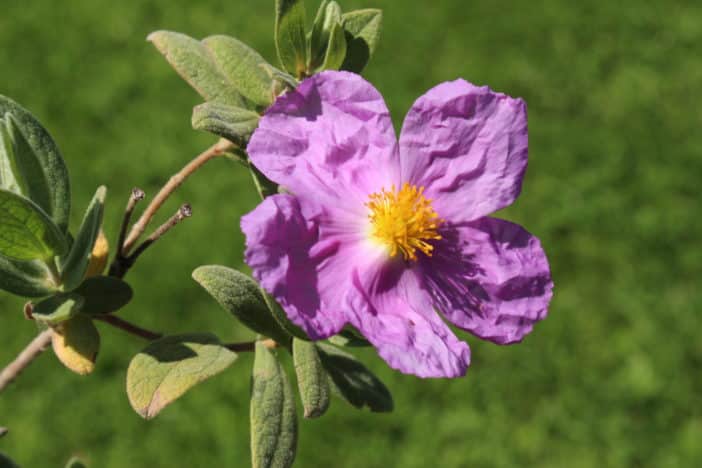Cistus extract

Interestingly, it is not the pretty white to purple flowers that are responsible for the healing powers, but mainly the hairy leaves. These leaves secrete a resin from countless tiny glands, which has an extremely high content of germicidal, antioxidant polyphenols. Today, these leaves are processed into cistus extract.
The cistus, a legendary and “Olympic” plant
According to a Greek legend, the cistus is an Olympic plant. In fact, it is said that the gods once met on Mount Olympus to assign various healing properties to the plants of the earth. The male gods wanted the cistus to be responsible for healing battle wounds, while the goddesses admired above all the delicacy of the flowers and saw the plants primarily in beauty care. Eventually, the parties involved agreed on a compromise and the cistus was given both properties, so that to this day it is allowed to serve beauty and heal at the same time. Whether this legend is true or not, rockrose does indeed have remarkable properties that benefit not only natural medicine but also cosmetics.
Cistus extract and its healing properties
The extract of rockrose can help especially with infections, bronchial diseases and eye diseases and has a hemostatic effect. It proves to be very effective especially in the case of colds. The polyphenols reduce the attack surface for bacteria and viruses on the mucous membranes, so that cold symptoms often recede quickly. Scientists even found out that the dangerous influenza viruses can “dock” only very badly by the ingestion of cistus extract and are washed away instead by mucus and saliva, which provides resistance during a flu wave for a clearly smaller infection risk. If an infection has already occurred, the course of the cold is at least considerably weaker and shorter, because the cistus extract inhibits the body’s own virus spread.
Since the mechanism of action is purely biophysical, no virus resistance has been observed to date. In this respect, cistus extract is in part even superior to antibiotics or pharmacological flu drugs.
Gargling and rinsing with cistus extract is recommended for aphthae, denture pressure sores, gingivitis and tonsillitis.
The plant is also known to eliminate heavy metals from the body. Due to its high tannin content and antispasmodic effect, tea made from cistus extract is also said to be very good for diarrhea, gastritis and intestinal cramps.
And last but not least, cistus extract is increasingly used to support Lyme disease therapy.
The cosmetic effect of rockrose extract
Poultices, baths, creams and lotions with cistus extract have itch-relieving, anti-inflammatory, soothing and emollient effects on the skin surface. Thanks to these properties, in recent years the extract has become an important component of holistic therapy for skin diseases such as atopic dermatitis. The plant is similarly effective for acne, eczema and sunburn. In a specialist clinic for skin diseases, it was observed as early as inthe 1990s that acne-related inflammations decreased significantly after only one month if the affected skin areas were treated twice daily with rockrose extract. Last but not least, cistus, which has an antioxidant effect, lends itself very well to anti-aging products. It ensures that the skin appears smoother and firmer, smaller wrinkles become less visible over time. It is not for nothing that pure cistus tea was popularly used as an anti-aging facial tonic in earlier times.
The ingredients of cistus extract
Cistus extract primarily contains valuable tannins, polyphenols, twelve important flavonoids, and essential oils such as cineole, limonene, and eugenol. The flavonoids include apigenin, quercitrin, ellagic acid and naringenin. These are known for their anti-cancer effects, among other things, and are also found in other healing foods: for example, pomegranate, celery, and grapefruit.
Cistus ingredients
INCI: Cistus Ladaniferus Oil
INCI:
INCI: Cistus Ladaniferus Leaf/Stem Water
INCI: Cistus Ladaniferus Flower Wax
CAS number: 8016-26-0
Description: yellow-brown to brown liquid
Cistus extract for sophisticated cosmetic products
The visually so delicate cistus has many positive properties, which unfold their effect optimally in the cistus extract. The extract is not only suitable for well-tolerated natural medicine, but also as a valuable ingredient for high-quality cosmetics. It achieves excellent results especially in the case of complaints such as acne, sunburn and neurodermatitis. Thanks to its strong antioxidant effect, it is also ideal for anti-aging formulations. Ask us: Cosmacon will be happy to develop effective and skin-compatible cosmetic products with cistus extract for you.
Literatur
Gaweł-Bęben K, Kukula-Koch W, Hoian U, Czop M.Antioxidants (Basel). 2020 Mar 1;9(3):202
Frazão DF, Martins-Gomes C, Steck JL, Keller J, Delgado F, Gonçalves JC, Bunzel M, Pintado CMBS, Díaz TS, Silva AM.Plants (Basel). 2022 May 31;11(11):1477